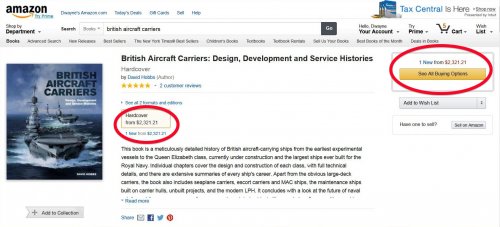- Joined
- 22 April 2012
- Messages
- 2,258
- Reaction score
- 2,305
Re: CVA-01
Planned is probably an overstatement, OR.346 was really only ever a sort of hypothetical next-generation construct to feed the requirements process and ultimately got broken up fairly quickly. Part of the way through the design process the size and weight of this hypothetical aircraft dropped which relieved some of the pressure on the design of the carrier.
According to Eric Brown, Wings On My Sleeve: The World's Greatest Test Pilot Tells His Story missile systems on the target ship are twice as effective as those in the screen so installing Seadart was simply the logical thing to do on CVA01. It is worth remembering that the Kitty Hawk class was built (except JFK) with Terrier whilst Enterprise was designed for that system but had it deleted on cost grounds and the Nimitz class were originally intended to take Tartar. As for Ikara, up until the 1962/3 redesign CVA01 was not going to have an organic ASW helicopter capability and the proposed escort cruisers would not arrive until well after CVA01 entered service so Ikara would have been the types primary ASW capability.
Abraham Gubler said:This is the OR.346 aircraft that the RN planned to acquire in both strike and fighter versions to replace the Buccaneer and Sea Vixen. Until sights were trimmed to P.1154 and Spey Phantom.
Planned is probably an overstatement, OR.346 was really only ever a sort of hypothetical next-generation construct to feed the requirements process and ultimately got broken up fairly quickly. Part of the way through the design process the size and weight of this hypothetical aircraft dropped which relieved some of the pressure on the design of the carrier.
The RN was planning in the 1960s of deploying their carriers in a very different way to the USN. The RN carrier group was to be widely dispersed with no close escort for the carrier. So CVA-01 had to be able to defend itself which was why Sea Dart and Ikara were planned. In the end Ikara was removed because it clashed with the hangar space, in particular the engine test area on the fantail.
According to Eric Brown, Wings On My Sleeve: The World's Greatest Test Pilot Tells His Story missile systems on the target ship are twice as effective as those in the screen so installing Seadart was simply the logical thing to do on CVA01. It is worth remembering that the Kitty Hawk class was built (except JFK) with Terrier whilst Enterprise was designed for that system but had it deleted on cost grounds and the Nimitz class were originally intended to take Tartar. As for Ikara, up until the 1962/3 redesign CVA01 was not going to have an organic ASW helicopter capability and the proposed escort cruisers would not arrive until well after CVA01 entered service so Ikara would have been the types primary ASW capability.



